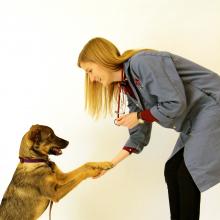The other day I had the pleasure of meeting Sue, a caring owner who was bringing her cat “Bug” to the clinic for his wellness exam. We got settled in the exam room and Mister Bug was doing his fair share of hissing and growling. Sue then reacted as many of us would, and apologized for the cat’s conduct, feeling guilty that he wasn’t on his best behaviour that day. This scenario occurs commonly in small animal medicine, where pets are not acting themselves at the vet’s, leaving their owners in shock, confusion, or guilt.
 Sue and Bug having a visit at the Prescott Animal Hospital with locum, Dr. Anthony Sekeres and myself.
Sue and Bug having a visit at the Prescott Animal Hospital with locum, Dr. Anthony Sekeres and myself.
I was reminded of a recent series of vet visits with my own dog, June. She is a “purebred Guatemalan street dog” that I adopted during my Global Vets trip last summer, and an absolute sweetheart when she’s at home, surrounded by people she trusts. However, when in a clinical setting, June is extremely anxious and gets fear aggressive. We tried many different things to make the experience more enjoyable, such as:
- Exercising a lot before an appointment
- Offering treats as positive reinforcement for good behaviour
- Coming in for cookie visits
- Administering trazadone
Despite trying out these various techniques, June did not grow fonder of the experience. We ended up deciding that sedation was the only way to keep June and the clinic staff safe. As a vet student, and general pet owner, this was a rather tough experience to go through because I’d like to think I did my best to socialize my dog and train her to be gentle and docile. The reality of it is that every pet harbours a unique personality and has their own way of reacting when being exposed to a clinical setting, and that’s OKAY.
Let's go back to the basics and remember that animals are fundamentally disparate from humans. They perceive the world differently than we do. Physiologically, animals are built to rely strongly on their sense of smell and hearing. When pets walk into a clinic, they are smelling the odors of the many fur balls that ventured before them, they hear that distant whimper of a companion waking up from surgery, and it’s all very overwhelming. In addition, we cannot explain to our pets why they are at the vet’s. All of their senses are triggered the moment they enter the clinic door, culminating to make one heck of an experience.
We must remember that a visit at the vets is often a big deal to our pets, and their behavioural response, be it positive or negative, is natural. The clinic staff is experienced in dealing with a wide variety of patients, and it takes much more than a bark or a hiss to offend us. The exam room is a place of open, non-judgemental conversation with the ultimate goal of keeping pets healthy and making the vet visit a positive one. So I encourage readers to learn more about positive clinic experiences by following the links below. And remember, it’s okay if your pet is more of a Wile E. Coyote than a Minnie Mouse; the most important thing is to keep them healthy through scheduled vet visits!
For the pet owner:
http://www.preventivevet.com/cats/removing-the-fear-and-anxiety-from-your-cats-vet-visits
For the clinic staff:
https://www.idexx.com/small-animal-health/solutions/articles/no-more-scaredy-cats-or-dogs.html
http://ovc.uoguelph.ca/news/recognizing-patient-fear-vital-positive-veterinary-clinic-visits
